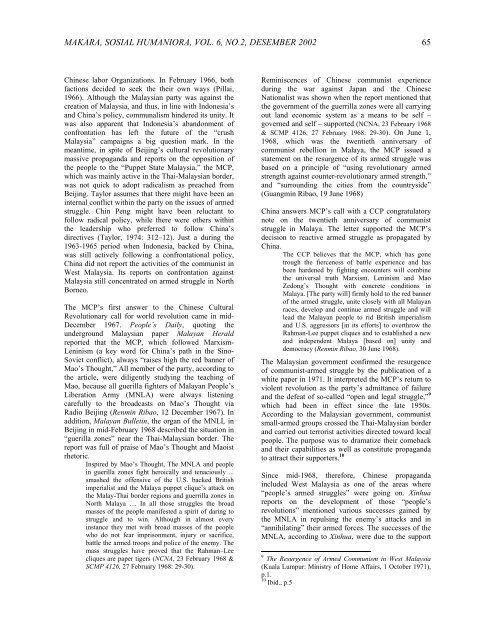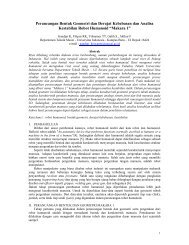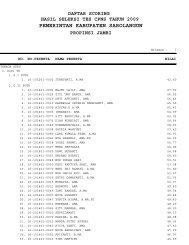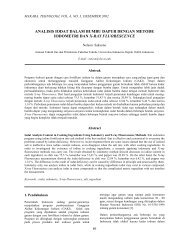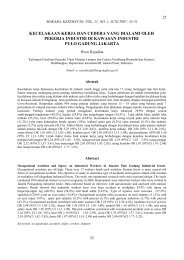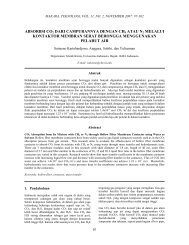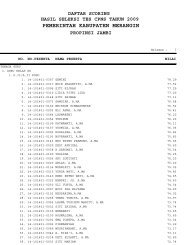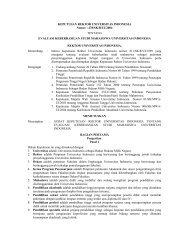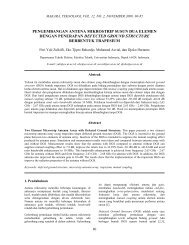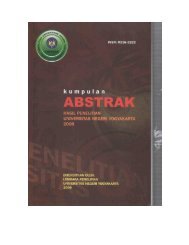“crush malaysia” campaign - Repository UI - Universitas Indonesia
“crush malaysia” campaign - Repository UI - Universitas Indonesia
“crush malaysia” campaign - Repository UI - Universitas Indonesia
Create successful ePaper yourself
Turn your PDF publications into a flip-book with our unique Google optimized e-Paper software.
MAKARA, SOSIAL HUMANIORA, VOL. 6, NO.2, DESEMBER 2002 65<br />
Chinese labor Organizations. In February 1966, both<br />
factions decided to seek the their own ways (Pillai,<br />
1966). Although the Malaysian party was against the<br />
creation of Malaysia, and thus, in line with <strong>Indonesia</strong>’s<br />
and China’s policy, communalism hindered its unity. It<br />
was also apparent that <strong>Indonesia</strong>’s abandonment of<br />
confrontation has left the future of the <strong>“crush</strong><br />
Malaysia” <strong>campaign</strong>s a big question mark. In the<br />
meantime, in spite of Beijing’s cultural revolutionary<br />
massive propaganda and reports on the opposition of<br />
the people to the “Puppet State Malaysia,” the MCP,<br />
which was mainly active in the Thai-Malaysian border,<br />
was not quick to adopt radicalism as preached from<br />
Beijing. Taylor assumes that there might have been an<br />
internal conflict within the party on the issues of armed<br />
struggle. Chin Peng might have been reluctant to<br />
follow radical policy, while there were others within<br />
the leadership who preferred to follow China’s<br />
directives (Taylor, 1974: 312–12). Just a during the<br />
1963-1965 period when <strong>Indonesia</strong>, backed by China,<br />
was still actively following a confrontational policy,<br />
China did not report the activities of the communist in<br />
West Malaysia. Its reports on confrontation against<br />
Malaysia still concentrated on armed struggle in North<br />
Borneo.<br />
The MCP’s first answer to the Chinese Cultural<br />
Revolutionary call for world revolution came in mid-<br />
December 1967. People’s Daily, quoting the<br />
underground Malaysian paper Malayan Herald<br />
reported that the MCP, which followed Marxism-<br />
Leninism (a key word for China’s path in the Sino-<br />
Soviet conflict), always “raises high the red banner of<br />
Mao’s Thought,” All member of the party, according to<br />
the article, were diligently studying the teaching of<br />
Mao, because all guerilla fighters of Malayan People’s<br />
Liberation Army (MNLA) were always listening<br />
carefully to the broadcasts on Mao’s Thought via<br />
Radio Beijing (Renmin Ribao, 12 December 1967). In<br />
addition, Malayan Bulletin, the organ of the MNLL in<br />
Beijing in mid-February 1968 described the situation in<br />
“guerilla zones” near the Thai-Malaysian border. The<br />
report was full of praise of Mao’s Thought and Maoist<br />
rhetoric.<br />
Inspired by Mao’s Thought, The MNLA and people<br />
in guerilla zones fight heroically and tenaciously ...<br />
smashed the offensive of the U.S. backed British<br />
imperialist and the Malaya puppet clique’s attack on<br />
the Malay-Thai border regions and guerrilla zones in<br />
North Malaya … In all those struggles the broad<br />
masses of the people manifested a spirit of daring to<br />
struggle and to win. Although in almost every<br />
instance they met with broad masses of the people<br />
who do not fear imprisonment, injury or sacrifice,<br />
battle the armed troops and police of the enemy. The<br />
mass struggles have proved that the Rahman–Lee<br />
cliques are paper tigers (NCNA, 23 February 1968 &<br />
SCMP 4126, 27 February 1968: 29-30).<br />
Reminiscences of Chinese communist experience<br />
during the war against Japan and the Chinese<br />
Nationalist was shown when the report mentioned that<br />
the government of the guerrilla zones were all carrying<br />
out land economic system as a means to be self –<br />
governed and self – supported (NCNA, 23 February 1968<br />
& SCMP 4126, 27 February 1968: 29-30). On June 1,<br />
1968, which was the twentieth anniversary of<br />
communist rebellion in Malaya, the MCP issued a<br />
statement on the resurgence of its armed struggle was<br />
based on a principle of “using revolutionary armed<br />
strength against counter-revolutionary armed strength,”<br />
and “surrounding the cities from the countryside”<br />
(Guangmin Ribao, 19 June 1968)<br />
China answers MCP’s call with a CCP congratulatory<br />
note on the twentieth anniversary of communist<br />
struggle in Malaya. The letter supported the MCP’s<br />
decision to reactive armed struggle as propagated by<br />
China.<br />
The CCP believes that the MCP, which has gone<br />
trough the fierceness of battle experience and has<br />
been hardened by fighting encounters will combine<br />
the universal truth Marxism, Leninism and Mao<br />
Zedong’s Thought with concrete conditions in<br />
Malaya. [The party will] firmly hold to the red banner<br />
of the armed struggle, unite closely with all Malayan<br />
races, develop and continue armed struggle and will<br />
lead the Malayan people to rid British imperialism<br />
and U.S. aggressors [in its efforts] to overthrow the<br />
Rahman-Lee puppet cliques and to established a new<br />
and independent Malaya [based on] unity and<br />
democracy (Renmin Ribao, 30 June 1968).<br />
The Malaysian government confirmed the resurgence<br />
of communist-armed struggle by the publication of a<br />
white paper in 1971. It interpreted the MCP’s return to<br />
violent revolution as the party’s admittance of failure<br />
and the defeat of so-called “open and legal struggle,” 9<br />
which had been in effect since the late 1950s.<br />
According to the Malaysian government, communist<br />
small-armed groups crossed the Thai-Malaysian border<br />
and carried out terrorist activities directed toward local<br />
people. The purpose was to dramatize their comeback<br />
and their capabilities as well as constitute propaganda<br />
to attract their supporters. 10<br />
Since mid-1968, therefore, Chinese propaganda<br />
included West Malaysia as one of the areas where<br />
“people’s armed struggles” were going on. Xinhua<br />
reports on the development of those “people’s<br />
revolutions” mentioned various successes gained by<br />
the MNLA in repulsing the enemy’s attacks and in<br />
“annihilating” their armed forces. The successes of the<br />
MNLA, according to Xinhua, were due to the support<br />
9 The Resurgence of Armed Communism in West Malaysia<br />
(Kuala Lumpur: Ministry of Home Affairs, 1 October 1971),<br />
p.1.<br />
10 Ibid., p.5


